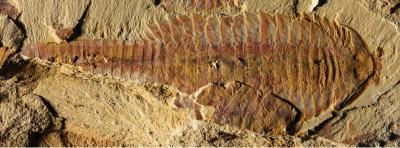520 Million-Year-Old Shrimp Has Earliest Vascular System, Fossil ‘Pristinely Preserved’ As Mudstone [PHOTO]

An ancient shrimp has shed major light on what one of the earliest known cardiovascular systems looked like.
Researchers working in China’s Yunnan province uncovered the remains of a 520 million-year-old fossil belonging to an extinct marine animal known as Fuxianhuia protensa. The three-inch fossil was preserved in what researchers call an "invertebrate version of Pompeii" where its vascular system remained remarkably well-preserved.
"This is the first preserved vascular system that we know of," Nicholas Strausfeld, a Regents Professor of Neuroscience at the University of Arizona's Department of Neuroscience, who worked on the study published in Nature Communications, said.

The fossil was preserved in fine-grain mudstone, most likely after a catastrophic event that entombed and later flattened it. “It is an invertebrate version of Pompeii," Strausfeld said in a statement, adding that a sandstorm or tsunami could have been the cause.
“The external structures of the animal were relatively decayed away and are preserved as an imprint of the body, but one single internal organ system is pristinely preserved as carbon trace,” study co-author Dr. Greg Edgecombe told MailOnline. “We had to rule out what it wasn’t, and were left with the cardiovascular system. Then everything fell into place.”
The small fossil is the first to show a vascular system complete with heart and blood vessels in a creature that lived half a billion years ago.
"Fuxianhuia is relatively abundant, but only extremely few specimens provide evidence of even a small part of an organ system, not even to speak of an entire organ system," Strausfeld said about the organism, which belongs to an extinct lineage of arthropods that had an advanced internal anatomy with a primitive body plan. "The animal looks simple, but its internal organization is quite elaborate. For example, the brain received many arteries, a pattern that appears very much like a modern crustacean."
Researchers made the discovery using an imaging technique that uncovered the animal’s internal structures based on its chemical composition. The shrimp’s heart was found to extend along the main part of the body. Its arteries were composed of carbon-rich deposits. This intricate system has led researchers to believe that the animal was capable of equally sophisticated behavior.
"Because of well-supplied blood vessels to its brain, we can assume this was a very active animal capable of making many different behavioral choices," Strausfeld said.
The findings suggest that the Fuxianhuia has an internal structure that resembled modern crustaceans.
"It appears to be the ground pattern from which others have evolved," Strausfeld said. "Different groups of crustaceans have vascular systems that have evolved into a variety of arrangements, but they all refer back to what we see in Fuxianhuia."
© Copyright IBTimes 2024. All rights reserved.






















